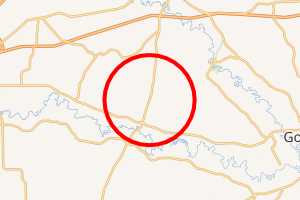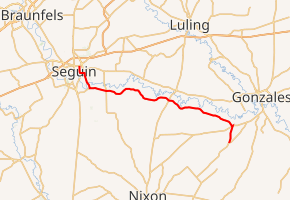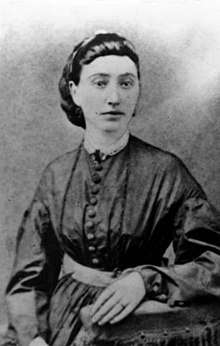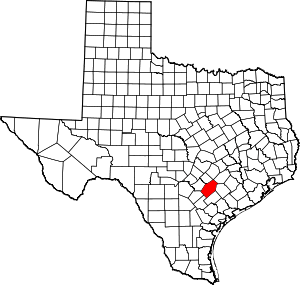Belmont, Texas
Belmont is an unincorporated area in extreme western Gonzales County south of ![]()
![]()
![]()
![]()
Belmont | |
|---|---|
Unincorporated Area | |

| |
| Settled | 1825-1836, DeWitt Colony (Eliza DeWitt Tract) |
| Founded | As late as c. 1850[1] |
| Founded by | U.S. Post Office customers |
| Named for | Dubiously, the Belmont Stakes; highly unlikely given the area was named before August Belmont began horseracing[2] |
| Government | |
| • Type | De facto |
| • Body | Fire authority and community services |
| • Fire | Belmont Volunteer Fire Department |
| • Elections | Belmont Community Center[3] |
| • River | Guadalupe-Blanco River Authority |
| • County | Gonzales County |
| Population (2016) | |
| • Total | 36 employed[4] |
| Location | North of Leesville, Texas |
| Website | Belmont VFD |
| |
|---|---|

| |
| Route information | |
| Length | 34.392 mi (55.349 km) |
| Existed | July 9, 1945–present |
| Major junctions | |
| West end | |
| East end | |
| Location | |
| Counties | Guadalupe, Gonzales County |
| Highway system | |
In 2016, Belmont had one construction operation, one wholesale trade operation, two retail trade services, one finance-and-insurance service and one accommodation-and-food service. All sectors reported 36 paid employees during this time, with a first-quarter payroll aggregating to $209,000 and total annual payroll of $816,000.[4] Historically, the general area has been associated with the industry of horsebreeding.
The area directly connects to the county seats of Seguin and Gonzales through Capote Road (FM 466), as well as served by the bridges and infrastructure of the nearby Guadalupe River.
Belmont shares a part of the history of the Old West as it's featured in The Ballad of Gregorio Cortez, and in the realities of the manhunt of Gregorio Cortez in the historical Battle of Belmont.
Services
Lake Gonzales
Lake Gonzales is a reservoir on the Guadalupe River 4 miles (6 km) southeast of the town of Belmont in Gonzales County, Texas. The reservoir was formed in 1931 by the construction of a dam to provide hydroelectric power to the area. Management of the dam and lake was assume by the Guadalupe-Blanco River Authority on May 1, 1963. Lake Gonzales also serves as a venue for outdoor recreation, including fishing, boating, swimming, camping and picnicking, and is maintained at a constant level year round.
Lake Gonzales is also known locally as H-4 Reservoir or Guadalupe Reservoir H-4.Capote Road
The road begins at an intersection with US 90 on the east side of Seguin, crosses US 90 Alt., heading south to cross the Guadalupe River. From there, it goes east, passing through Monthalia. At Cost, it joins SH 97, just south of Gonzales.
Capote Road passes through a rural area that at one time was heavily farmed. In more recent years more of the sandy land has been given over to pastures, and reverted to post oak woodlands, which support a good population of wildlife, including wild turkeys and deer. The Guadalupe River runs more or less parallel a mile or two to the north, much of its bottomlands filled with pecan orchards. Old Baldy and the other Capote Hills rising above the flatlands provided a landmark for travelers in the pioneer days. Wildflower season sees groups of phlox and fields of bluebonnets, rose cups and buttercups, then gaillardia or Indian blankets, and sunflowers and nettles in the summer, sometimes punctuated by clusters of colorful blossoms on prickly pear cactus.History
The Belmont area was originally settled by Eliza DeWitt after January 1830, when she eventually received a DeWitt Colony land grant in the April of 1831; she had moved from St. Louis County, Missouri. She was later widowed twice, with one of her husbands killed by Native Americans. Her third marriage was in Houston. Her original DeWitt Colony land grant is the oldest established tract completely within Belmont, preceding the Texan Revolution.
Most of Belmont's urban facilities share the Ira Nash tract, a DeWitt colonial-tract, with rural Kingsbury in the northwest.[11][6]
Belmont—Old Seguin
The town of Seguin was founded August 12, 1838, 16 months after Texas won its independence at the Battle of San Jacinto, making it one of the oldest towns in Texas. Members of Mathew Caldwell's Gonzales Rangers acquired land originally granted to Umphries Branch, who had departed during the Runaway Scrape and sold his land to Joseph S. Martin.[12]
At this time, the Seguin area was a part of Gonzales County, the remaining portion known as present-day Belmont. The Rangers had found this was a good halfway stop between their patrol points. The big oaks and walnut groves along the Walnut Branch, had become a familiar and pleasant location. It had been maintained as a base camp by the rangers since the early founding of the Dewitt Colony.[13]Old Billy horsebreeding
Born in Lumpkin County, Georgia, in 1830, William B. Fleming came to Texas before 1850 where he enlisted in Company C of the Texas Rangers Mounted Volunteers and later the Confederate Army during the Civil War. After the war, Fleming moved to Gonzales County. In partnership with Charles Erasmus Littlefield in 1871, Fleming purchased land on the Guadalupe River south bank in Belmont. Fleming erected a dog run-style cabin of black walnut logs where remnants can still be found.
Fleming purchased his first horse known as "Old Billy" and used him to breed a line of quarter horses known as "Billys". Cowboy, rodeo performers and racing enthusiasts coveted Billy horses and Fleming was one of the premier horse breeders of his day.[14]
Belmont—Old Nixon

In 1852, Robert T. Nixon at the northern Gonzales—Guadalupe County line founded the original settlement of Nixon, now known as the ghost town "Old Nixon;" a former 14,000 acre plantation between Belmont-Luling.[15]
The Old Nixon facility, despite being fenced at 14,000 acres at its precipice, began at an original capitalization of $800 for 400 acres of land; with no original "free land" grants of early Texas. During Juneteenth 1865, the plantation was not affected by the abolishment of slavery, as the plantation had no slaves. Cattle and horse-breeding were the primary occupations of this enterprise, the latter being featured in The Quarter Horse journal of July 1947; featuring the early 1900s, when the Old Nixon plantation under Dr. J.W. Nixon, hosted the first "Joe Bailey" Quarter Horse, a foremost founding sire of the breed.[16][17][18]
In 1899, Old Nixon at Guadalupe County had a cotton gin (Nixon-family owned), two schools, a church, a blacksmith, several residences; alongside "Wagner's Store" and "Nixon and Stephens: Dealers in Dry Goods, Notions, Fine Groceries and General Merchandise." The latter was owned by W.H. Stephens and Sam Nixon. Robert T. Nixon's brother John T. Nixon lived at Rancho near what is now northern Nixon in southern Gonzales County. The name of Nixon was later taken from the former town and applied to the new town formed on John T. Nixon's land.
The only remaining establishment of the original Old Nixon settlement is its cemetery.[19][20][21]Notable people
Martin Beaty
Martin Beaty (October 8, 1784 – June 17, 1856) was a United States Representative from Kentucky. He was born in Abingdon, Virginia. In his life, he worked as an iron furnace operator, a salt manufacturer, a rancher, and a farmer.
Beaty was a member of the Kentucky Senate 1824–1828 and 1832. He served as a Presidential Elector for Henry Clay and John Sergeant in 1832 and William Henry Harrison and Francis Granger in 1836. He was an unsuccessful candidate for election to the Twenty-first Congress in 1828 and to the Twenty-second Congress in 1830 but was elected as an Anti-Jacksonian to the Twenty-third Congress (March 4, 1833 – March 3, 1835). He was an unsuccessful candidate for reelection to the Twenty-fourth Congress in 1834. After leaving Congress, he was a member of the Kentucky House of Representatives, 1848. He died in 1856 in Belmont, Texas where he was buried in Belmont Cemetery.Gregorio Cortez
| The Ballad of Gregorio Cortez | |
|---|---|
| Directed by | Robert M. Young |
| Produced by |
|
| Screenplay by |
|
| Based on | With His Pistol in His Hand by Américo Paredes |
| Starring | Edward James Olmos |
| Music by |
|
| Cinematography | Reynaldo Villalobos |
| Edited by |
|
Production company |
|
| Distributed by | Embassy Pictures |
Release date |
|
Running time | 106 minutes |
| Country | United States |
| Language | English Spanish |
| Box office | $804,963 |
After escaping, Cortez went to the ranch of Martín and Refugia Robledo near Belmont, Texas. There were seven persons at the Robledo house. Martín and Refugia Robledo, their three sons, Ramón Rodríguez (a boy living with the Robledos) and a visitor, Martín Sandoval. Gonzales County Sheriff Robert M. Glover, a friend of Sheriff Morris, knew where Cortez was hiding, probably from information obtained under duress. This information would have been either provided by Cortez's mother, wife or sister-in-law as they were the only people who knew where Cortez was going.[22]
According to the Texas Court of Criminal Appeals report of facts, on June 15, 1904, at the time Sheriff Morris was killed, Sheriff Glover was in Cuero, DeWitt County, Texas. Glover proceeded with a deputy sheriff of De Witt County to Kennedy, in Karnes County, and there for the first time learned that Cortez was the man who had killed Sheriff Morris. Glover, knowing the rendezvous of Cortez, boarded a train in about twenty minutes after receiving the information that Cortez had done the killing and proceeded as expeditiously as he could to the town of Ottine, in Gonzales County; there secured horses, and accompanied by two deputy sheriffs of Gonzales County, including Deputy Swift, and other parties, went a few miles in the country to the Schnable ranch; and there learned that Cortez was at the home of Martin Roblero. He and his posse went to Roblero's. The posse divided as they approached the house from the north side; Glover and one or more companions going on the east side of the house around to the south side; and the other parties going on the west side around to the south side of the house. According to the Court, some of the testimony tends to show that the sheriff's posse shot first; but the preponderance of the evidence shows that Cortez and Bonafacio fired the first shot. Just before the time that the sheriff's posse arrived at the house, Cortez informed Bonafacio that the Sheriff's troop would be on his tail and asked him what he should do, whether to fight or surrender. Bonafacio would have said, "We will fight". Immediately upon Glover getting around to a point opposite the gallery on the south side of the house, Cortez and Bonafacio Roblero (the Roblero's eldest son), who were in the gallery, allegedly fired upon Glover and killed him. There was a general fusillade of shots on the part of the posse and Cortez and Bonafacio. On the other hand, in his testimony, Cortez asserts that the officers came up and immediately fired upon him; that he returned this fire.[23]
The San-Antonio Express called the Battle of Belmont, as it came to be known, “a tale of bravery unsurpassed on the part of the officers and of desperation on the part of the Mexicans.”. According to this version of the story, Cortez was waiting in ambush, and as Sheriff Glover and Posseman Schnabel approached, he opened fire. Sheriff Glover and Posseman Schnabel were killed[24]
The actual story, according to the scholar Américo Paredes, was less heroic. Just hours after Cortez arrived at the ranch, Glover and his posse had surrounded the house and began to attack. Cortez fired at Glover, who fell dead, and Cortez ran into the brush behind the house to hide. Robledo, his eldest son, and Sandoval were involved in the shooting, while Robledo's wife, his two younger sons and Ramón Rodríguez stayed unarmed inside the house. Shots were exchanged and Ramón Rodríguez was wounded, as well as Robledo’s wife. Another member of the posse shot and killed accidentally his companion, Henry Schnabel. In the end, the posse captured five of the Mexicans, including the two wounded. Cortez, however, escaped.[25]The Ballad of Gregorio Cortez
See also
- Monthalia, Texas; Belmont-bridge bypass
References
- "BEATY, Martin (1784-1856)". Biographical Directory of the United States Congress. Office of the House Historian. Retrieved 6 August 2020.
- "BELMONT, TX". Texas State Historical Association. Retrieved 6 August 2020.
- ...Pct. 5 – Belmont Community Center, 14335 Hwy 90A W...
- "ZIP 78604 (Belmont, TX)...ZIP Code Business Statistics: Zip Code Business Patterns by Employment Size Class: 2016". United States Census Bureau Economic Annual Surveys. Retrieved 21 January 2020.
- The intersection of state Highway 80 and FM 466...location just south of Belmont in extreme western Gonzales County...rural intersection near Belmont...in the Belmont area, particularly at that intersection...
- "Library of Congress; Gonzales County, Texas". Retrieved 5 September 2018.
- "Belmont, TX 2019" (PDF). US Department of the Interior, US Geological Survey.
- ...The Belmont Volunteer Fire Department would like to thank everyone who helped in making their annual fundraiser a success. They sold over five hundred plates. They raised over $17,000.00 in the auction and donations. It takes a lot of money to keep and maintain the building, and trucks and the costs of fuel etc. When you look at this Belmont VFD, it is a top notch department in training and the best equipment that it can afford. We are all very proud of their new fire truck...
- ...members of the Belmont Volunteer Fire Department – who are usually the first to arrive at the scene of accidents...Richard Goss with the Belmont VFD...
- ...Belmont VFD fundraiser coming up...
- "The Gonzales Connection: The History and Genealogy of the Dewitt and Jones Families". 2004. Retrieved 6 August 2020.
- "DeWitt Colony Land Grants-North". Tamu.edu. Retrieved 18 December 2015.
- Famous Trees of Texas TAMU
- "William B. Fleming - Texas Historical Markers". Waymarking.com. The State of Texas. Retrieved 11 August 2020.

- "Nixon Photographs & Biographical Materials". UT Health San Antonio. UT Health Science Center Library. Retrieved 14 May 2020.
- Bateman, Ed (July 1947). "Nixon Horse In Many Top Quarter Pedigrees". The Quarter Horse. 2 (4): 0.
|access-date=requires|url=(help) - "Gonzales Joe Bailey moved to park". The Gonzales Inquirer. Retrieved 26 July 2020.
- Nixon M.D., Pat (1956). The Early Nixons of Texas. University of Wisconsin: Carl Hertzog, El Paso, Texas.
- Bond, Mary (1982). "First Old Nixon settler arrived in 1852". The Seguin Gazette-Enterprise. Retrieved 14 May 2020.
- Nixon M.D., Pat (1956). The Early Nixons of Texas. El Paso: Herzog.
- Limmer, Jessica. "Nixon became 'Old' with birth of nearby town by same name". The Seguin Gazette. Retrieved 14 May 2020.
Nixon — later known as Old Nixon — was founded by Robert Nixon, who in 1852 settled in far eastern Guadalupe County between Belmont and Luling...Robert was known to host Methodist circuit preachers at his home, who would then minister to the community during their stay..."When there wasn't a circuit preacher visiting, they would have to get up before dawn to get to church in Belmont,"...The railroad...pulled Old Nixon residents to Luling...
- Paredes 2016, p. ??
- Cortez v. State, 83 S.W. 812 (Tex. Crim. App. 1904)
- San Antonio Express, June 16, 1901
- Paredes 2016, p. ??
- Criterion Collection
- Maslin, Janet (14 October 1983). "Film: 'Gregorio Cortez'". The New York Times. Retrieved 26 December 2017.

